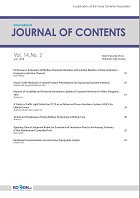- Log In/Sign Up
- P-ISSN1738-6764
- E-ISSN2093-7504
- KCI
 ISSN : 1738-6764
ISSN : 1738-6764
An Empirical Analysis of Auditory Interfaces in Human-computer Interaction
Abstract
This study attempted to compare usability of auditory interfaces, which is a comprehensive concept that includes safety, utility, effectiveness, and efficiency, in personal computing environments: verbal messages (speech sounds), earcons (musical sounds), and auditory icons (natural sounds). This study hypothesized that verbal messages would offer higher usability than earcons and auditory icons, since the verbal messages are easy to interpret and understand based on semiotic process. In this study, usability was measured by a set of seven items: ability to inform what the program is doing, relevance to visual interfaces, degree of stimulation, degree of understandability, perceived time pressure, clearness of sound outputs, and degrees of satisfaction. Through the experimental research, the results showed that verbal messages provided the highest level of usability. On the contrary, auditory icons showed the lowest level of usability, as they require users to establish new coding schemes, and thus demand more mental effort from users.
- keywords
- Auditory Interface, Verbal message, Earcon, Auditory icons, Usability
- Downloaded
- Viewed
- 0KCI Citations
- 0WOS Citations

